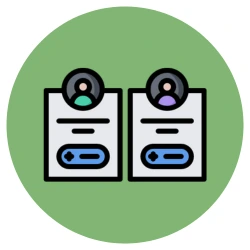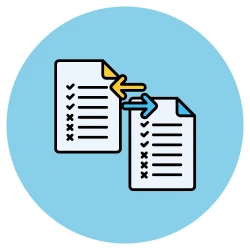STAND OUT IN THE 2025 JOB MARKET:
THE (ULTIMATE GUIDE) TO BECOMING A RECRUITER MAGNET
A complete guide to getting noticed by recruiters to land your dream job in 2025.
So if you’re:
- Unemployed or under-employed
- Employed but seeking a better position
- Interested in being on recruiters’ radar for the future
Then you’ll love the actionable tips in this guide.

Chapter 1:
Why Become a Recruiter Magnet
Why become a recruiter magnet, and is it worth the effort?
For some, the benefits may seem obvious. However, for others, the advantages are not so clear. Let’s explore these benefits, debunk misconceptions, and understand why investing your time and effort to become a recruiter magnet is worthwhile.
Important Note: In this guide, when I mention the term “recruiter,” it encompasses both internal recruiters employed by the company and external recruiters contracted by the employer. Employers typically rely on external recruiters when they can’t find the specialized, high-quality talent they need through job postings. This is particularly true if they don’t have an internal recruiter, or if their in-house recruiter lacks time to recruit passive candidates, and/or sift through a mass of unfiltered applicants.
Four reasons to be a recruiter magnet:
► Access the Hidden Job Market: Recruiters act as gatekeepers to a massive ‘hidden job market.” Experts suggest that up to 60-80% of all job opportunities are hidden, meaning they are not advertised publicly. Internal recruiters often source passive candidates for positions when posting a job fails to get the employer the specific high-quality talent they seek. Additionally, jobs become “hidden” when a company wants to keep the search confidential, often engaging an external recruitment agency.
Most external recruiting agencies don’t post positions and focus on sourcing passive candidates. I cover why passive candidates are preferred over applicants in Chapter 5.
RED ALERT #1: If recruiters can’t easily find and recognize you as a top-tier candidate for their roles, you could miss out on a significant portion of the opportunities in your field, leaving you to compete with the masses for advertised jobs.
► Less Noise: When a job isn’t advertised to the public, it naturally cuts down the pool of candidates, improving your odds of standing out. Instead of being among hundreds or thousands applying for an advertised position, you are often one of three to five candidates handpicked by a recruiter for the hiring manager. A polished and effective LinkedIn profile that catches a recruiter’s eye can make a significant difference. You won’t get lost in a flood of applications; instead, stand out, increasing your chances of securing an interview and ultimately landing the job.
► Higher Perceived Value: Whether right or wrong, the reality is that recruiters and employers often perceive passive candidates – those who are employed and not actively looking for a new job – as more desirable. They are generally satisfied in their current roles and are likely to move only for the right opportunity. When you’re on a recruiter’s radar, you fit into this high-value category, improving your chances of being considered for premium roles.
► Mindset Shift: Upon seeing the title of this guide, some might wonder, “Why would I want to attract recruiters who can be annoying?” It’s true that recruiters, like lawyers, salespeople, contractors, politicians, and so on, often face a general perception of being troublesome. However, it’s important not to let a few negative experiences with recruiters deter you from the many benefits of being a magnet for recruiters.
Engaging with recruiters shouldn’t be seen as a nuisance but rather a long-term investment. Interacting with recruiters is worth your time, as it provides valuable interview practice, industry insights, and salary information. It provides insights and information that could help your negotiations in your current role or future job offers.
Here is my story as proof: Before launching salestalent.com, becoming a recruiter magnet was the most important factor positively impacting my career. 🧲
👉 Three of my last four jobs came through recruiters. They approached me. The opportunities were significant, and my income nearly doubled each time.
These inbound opportunities also enabled my transition from non-tech sales to SaaS, a career transition many find challenging.
I’m both a recruiter and a beneficiary of previously being a recruiter magnet. I know the value of this strategy. That’s why I’ve written this guide and I’m eager to share it with you.
Becoming a recruiter magnet allows you to tap into the vast pool of unseen opportunities. Embrace the magnetism and the effort it requires, and you will unlock doors to numerous career opportunities when recruiters are magnetically drawn to you.
Chapter 2:
First Impressions Matter
First impressions matter and are rarely made by your resume.
Most people spend more time on their resume than their LinkedIn profile. Neglecting their LinkedIn profile is a mistake and holds people back from a better career. If you learn one thing from this guide, it is that you should spend much more time on your LinkedIn profile than your resume.
This suggestion may seem counterintuitive and go against everything you may have been told about the importance of a resume. In today’s connected world, the most challenging part of securing any new position is getting in the door. Getting in the door often relies heavily on your first impression and how you differentiate yourself.
It is difficult to differentiate yourself based on your resume as resumes often look and read the same. They also lack the attributes of LinkedIn profiles that allow differentiation.
RED ALERT #2: Those seeking to hire view Your LinkedIn profile more often than your resume. Think about it. Your resume gets dusted off and viewed every few years, while multiple recruiters view your LinkedIn profile weekly. Keep reading to learn why you rarely see these recruiters in your “Who’s viewed your profile” page.
Recruiters and hiring managers use your LinkedIn profile to determine whether you are somebody they should interview. Your resume is only reviewed before or during the interview process.
The hard truth is that your LinkedIn profile gets you in the door, which is the hard part, and your resume might back up the decision to let you in the door.
Here are five reasons you want your LinkedIn profile to be your first impression.
1. Visibility and Accessibility:
LinkedIn profiles are accessible to anyone online, significantly broadening your audience compared to a traditional resume. Recruiters can stumble upon your profile while searching for potential candidates, which could result in more job opportunities. You don’t need to apply for a specific job for someone to find your profile, creating a passive job-seeking benefit as well.
2. Dynamic Content:
Unlike a static resume, a LinkedIn profile can display a more comprehensive view of your professional experience. You can include videos, images, presentations, and links to your work, giving recruiters a deeper understanding of your capabilities and achievements.
3. Recommendations and Endorsements:
LinkedIn allows other professionals to endorse your skills and write recommendations, which adds credibility to your profile. This isn’t part of a traditional resume and can benefit potential employers.
4. Real-time Updates:
A LinkedIn profile can be updated regularly, allowing you to add new skills, experiences, and accomplishments as they happen. This ensures your profile is up to date, reflecting your current professional situation.
5. More Credible:
Because LinkedIn profiles are highly visible and accessible, people are less likely to embellish their backgrounds and accomplishments. A resume is usually not seen by current or former coworkers who can call bullshit on inaccuracies, whereas a LinkedIn profile may be. As recruiters, we often see accomplishments listed on a resume and not on a LinkedIn profile.
Don’t Let the Sun Go Down on Me
Let’s dive deep into how to ensure your LinkedIn profile makes the best first impression. But first, I will pull back the curtain on the passive candidate sourcing process. Understanding the process will help illustrate why making the best possible first impression is critical.
To best illustrate the passive candidate sourcing process, I’ll offer a parody of an Elton John hit to demonstrate why you need an optimized profile.
Don’t let them scroll right on by me
Although I search myself, I hope it’s my profile they click to see
I’m just asking for a moment’s chance
To get to the big dance
Don’t let them close that tab on me
This ditty should echo through your mind while you work on your LinkedIn profile.
Here’s why:
Although the process varies for each recruiter, I’ll describe a common passive candidate sourcing process. After the recruiter has worked with the hiring manager to define the Ideal Candidate Profile, they begin the search. (I cover the importance of Ideal Candidate Profile in Chapter 3.
Typically a recruiter starts with a search on LinkedIn Premium Business, Sales Navigator, or Recruiter. They aim to build a funnel that concludes with 3 to 5 vetted candidates they submit to the hiring manager.
The numbers vary, but here is an example from a typical SaaS Account Executive search.
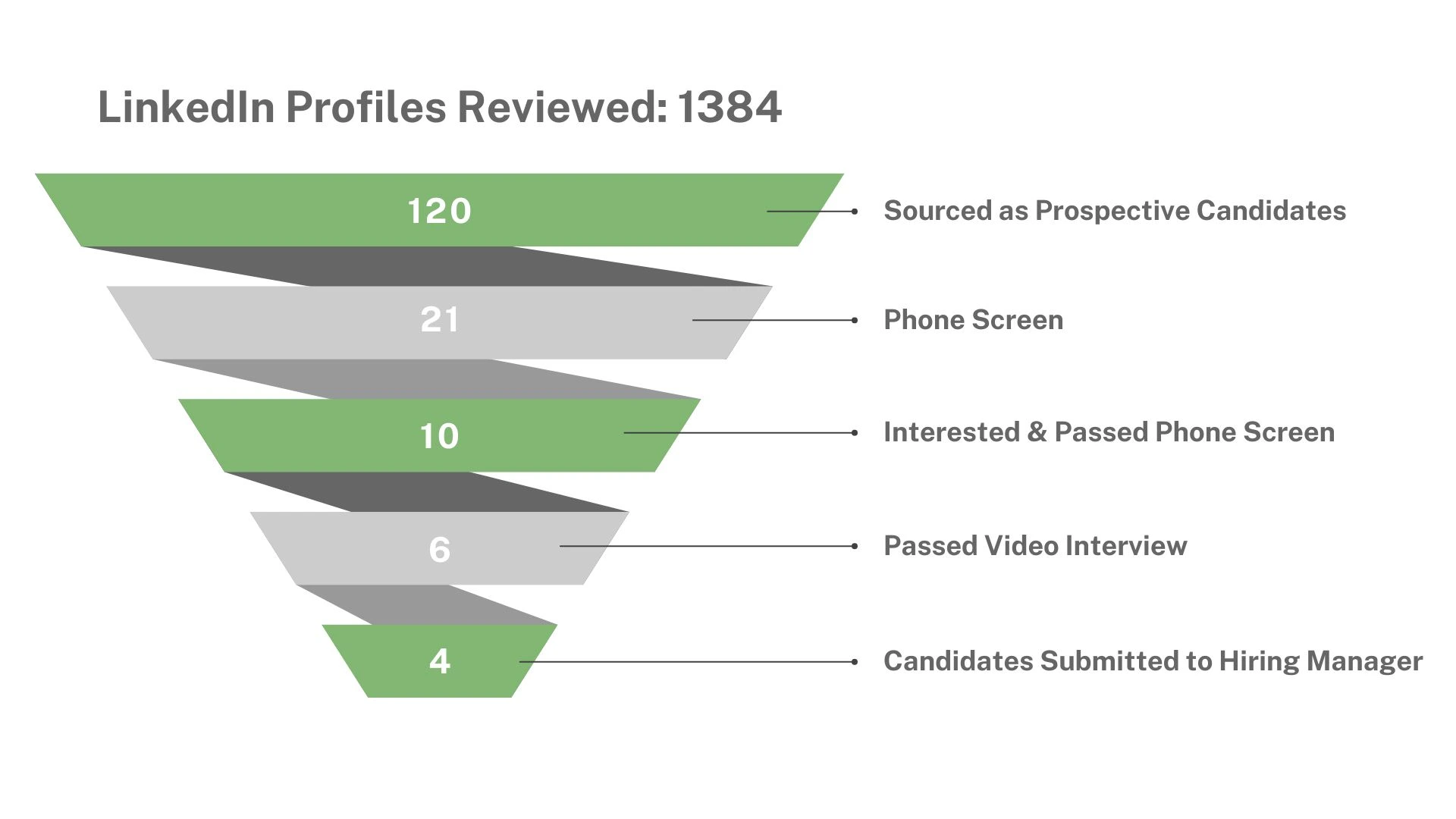
As you can see, the recruiter looks at many profiles to build the funnel.
Recruiters kiss a lot of frogs to find ideal candidates.
RED ALERT #3: ~90% of potential candidates don’t make it past the first stage of the funnel. One of the big reasons is their profile sucks!
Sadly, the rejected candidates often don’t know how many recruiters look at their profile and move on. Many recruiters review profiles using private mode, so no one knows they viewed them.
Let’s touch a bit more on the sourcing process before moving on to how to ensure your profile does not suck.
Returning to the funnel example, the recruiter will search for Account Executives. If the first search yields 1000 results, they will go through 40 pages of search results—25 profiles per page.
That means your first challenge is getting noticed and chosen from among the 25 results on each page.
Side note: Some recruiters limit their initial search to 1st and 2nd connections, so the more connections you have, the higher the chance you appear in the search. I cover the importance of connections in Chapter 5.
Here is how a profile appears in the search results on LinkedIn Premium Business:
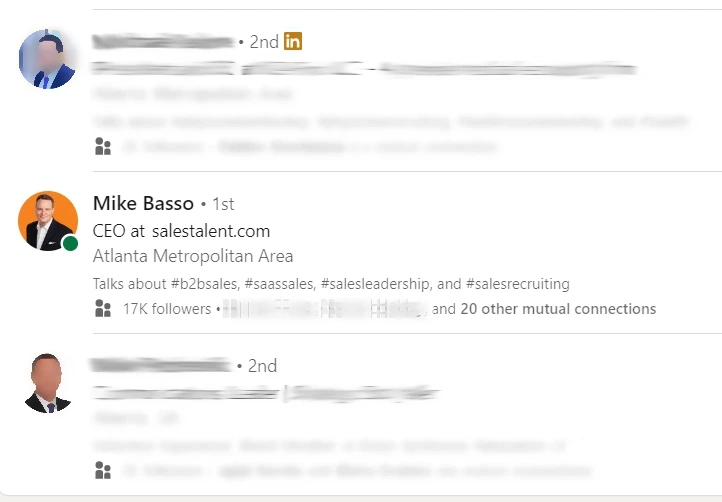
A LinkedIn people search result consists of a photo, name, headline, location, and connection type. If the person is a 1st level connection, the number of shared connections will appear along with a few names of common connections. If the person has creator mode turned on, the topics they write about will also appear.
As you see, the recruiter does not have much info to decide whether a person is click-worthy based on the ideal candidate profile.
The two aspects they focus on more than any are headlines and photos. You are unlikely to reach the profile view stage if these two key elements are wrong. Your headline and photo can cost you the opportunity to be considered. Ouch!
Let’s look at how so many people get headlines and photos wrong.
To go through 1,000 search results, recruiters must make split-second decisions. They spend less than a second on your profile.
A missing photo or an inappropriate photo can result in being passed over. Let’s look at each separately, starting with your photo.
No photo: Most recruiters do not click on a profile that does not have a photo. This might be a surprise, and you might ask why.
Here’s why: When sourcing candidates, recruiters play the odds based on their experience. Their experience tells them that a possible candidate without a profile photo is likely a low-quality candidate.
If you don’t have a photo, you are broadcasting that you don’t care enough about your career to get and upload a photo.
Recruiters don’t care what you look like. They want to know you are someone who invests in your professional career. It is the first gate you must pass to become a vetted and submitted candidate.
Some may say, I have a photo, but I have it set to show only for 1st connections. Ask yourself what is more important—privacy or having more job opportunities? The harsh reality is that you can’t have both.
If you don’t want to be passed over because you don’t have a photo, invest time and money in your professional career and get a quality photo. My profile photo is from Target Studio and cost $299. The profile photo has returned hundreds of thousands of dollars on my investment. A professional profile photo is the best investment you can make.
So, what is equally detrimental as no photo? A bad photo.
Bad Photo = Recruiter Repellant
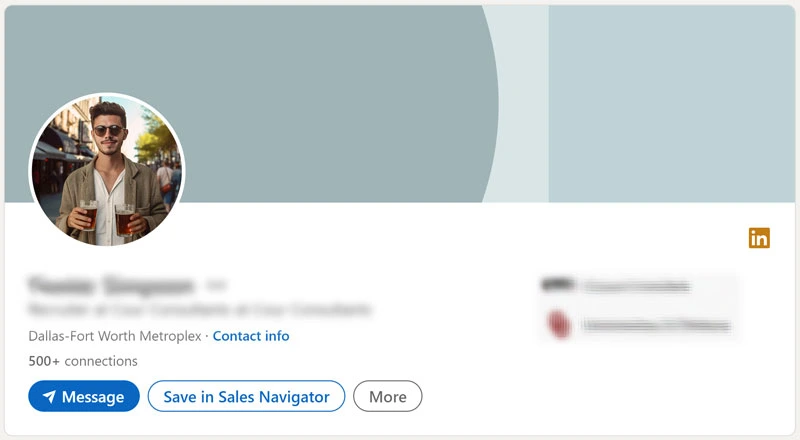
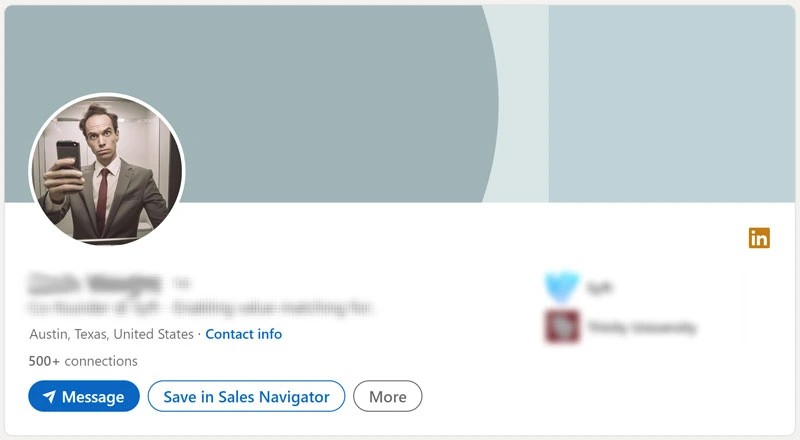
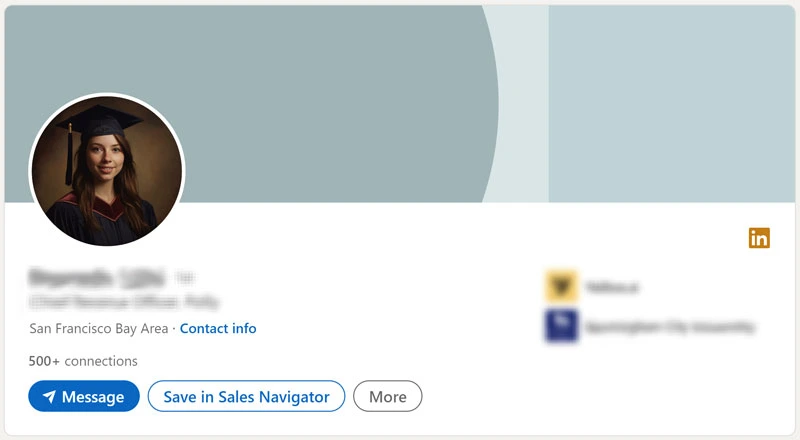
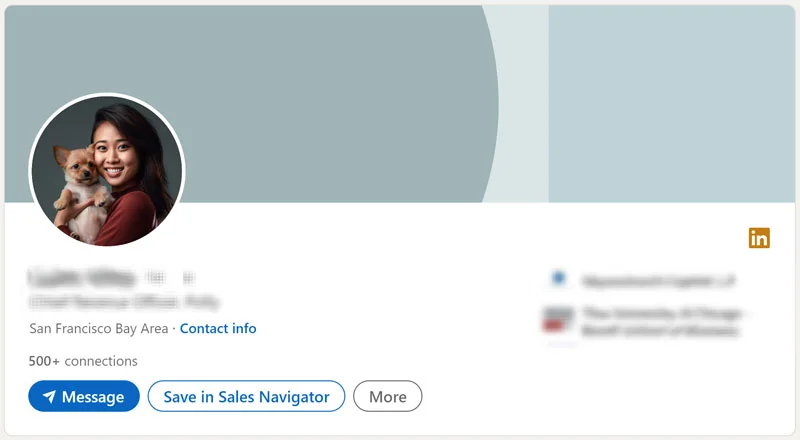
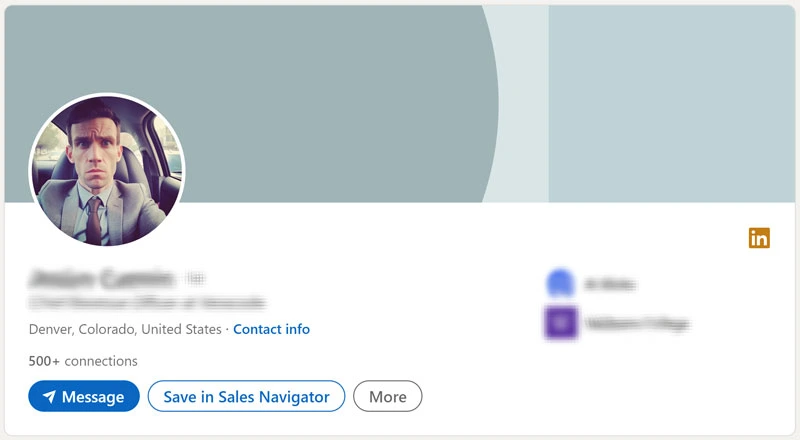
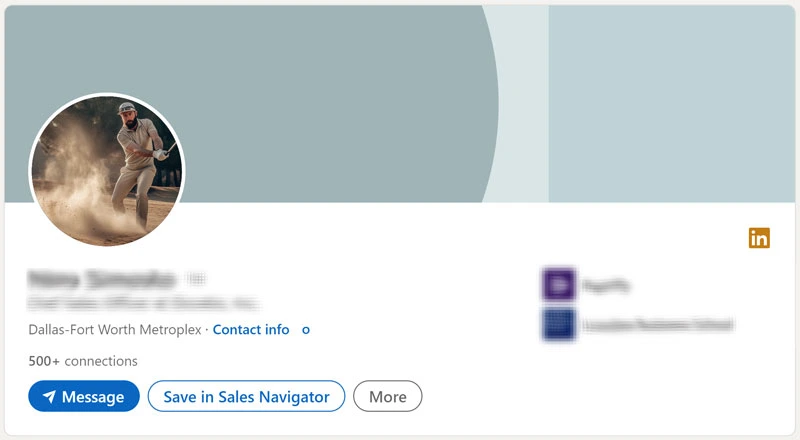
*All profiles were spared embarrassment as we replaced the human photos with AI-created images.
LinkedIn Profile Picture (Don’ts)
❌ DON’T include multiple people
❌ DON’T show alcohol
❌ DON’T use a close-cropped picture
❌ DON’T use a car selfie
❌ DON’T use a mirror selfie
❌ DON’T use a wedding photo
❌ DON’T include your pet
❌ DON’T wear sunglasses
❌ DON’T be engaged in sports
❌ DON’T use your class or graduation photo
❌ DON’T use a vacation photo
📸 Invest your time and money in a photo shoot with a professional photographer. Avoid using a selfie or a photo taken by an amateur using a cellphone. Many conferences and tradeshows now offer a free photo session as a perk for attending. Take advantage if you have the opportunity. My final thought on photos is that I do not like cartoon or AI-stylized headshots. These photos do not show your authentic self and add the risk of appearing egocentric.
Opportunity Killing Headlines
A compelling headline will not cost money like a photo but will require time and thought to ensure it is optimized and effective. The tricky part is that it needs to serve several purposes. Specifically, your headline needs to be a recruiter magnet and appropriate for customers and your current employer.
If you are employed, you don’t want it to scream, “Hey, I looking to leave” to your employer. Hopefully, you are in a position where you don’t have to leave your current employer but are always open to better opportunities when they come along. Your headline should fit your near and long-term objectives.
Let’s discuss what makes for a bad headline and then look at some examples of common bad headlines.
❌ The Buzzkill Headline – A headline filled with overused or clique buzzwords such as Results-Oriented, Team Player, Passionate, Fast Learner, Motivated, Experienced, Expert, Jack of All Trades, Creative, Strategic, Skilled, Thought Leader, Guru, Rock Star, Experienced, Ninja, Proactive, Superior, Hard-Working, or Dedicated.
❌ The Quadruple Stack – Maxing out the 240 characters allowed and stuffing it with irrelevant fluff. This is a sure way to get skipped in the search results. Your headline should not exceed 120 characters.
❌ The Tight-Lipped Headline – This is the opposite of the quadruple stack like one or two-word headlines such as sales or programmer. Be sure to provide a more specific title, such as SaaS FinTech Account Executive.
❌ I Help Others but NOT Myself Headline –A common sales headline is: I help (customer) achieve (x) results. The problem with this headline is that it does not include their title. Start with your title, then state how you help the client.
❌ The Default Headline – Don’t let your headline default to your current job title. Put effort into optimizing your headline.
❌ EmojiLand Headline – Humans and search engines have difficulty understanding emojis and can be seen as unprofessional. If you must use emojis, place them after the important content.
❌ Megaphone Headline – An ALL CAPS headline is wrong in so many ways.
❌ Desperately Seeking Headline – Unless you are a recent college graduate, you should avoid using phrases such as “open to work,” “seeking employment,” “unemployed,” or “seeking a VP of Sales role.” (I will address why in detail later in the Passive vs. Applicant chapter.)
Bad Headline Examples

This headline is a quadruple buzzkill. It is long, scattered, and a buzzword wasteland. It comes off as arrogant and gives little title detail.

Mary makes the common mistake of not changing her default LinkedIn headline. Her headline does not differentiate her from other AEs.

It is great that Mike demonstrates how he helps customers. However, he does not help himself or recruiters by not including his title.

As a recruiter, I find those who call themselves rock stars seldom are. If you are, show it with referenceable stats.

Bob’s headline hinders him more than helps him. We will dive into why this type of headline hinders in the chapter Passive vs. Applicant.

Dear Jane, What level of sales leader are you? Manager, Director, VP? I won’t click on you if you force me to guess. Yours Truly, Recruiter
Good Headline Examples

Balanced between representing company, speaking customer value, and showing a specific Candidate Profile without being obvious.

Jane’s profile speaks to a very specific candidate profile. A recruiter looking for a CRO who’s scaled Healthcare SaaS companies will click on Jane’s profile.

Another balanced headline that speaks customer value while showing a key accomplishment and clarifying fit with Ideal Candidate Profile.

Brian’s specialty is being a successful founding Account Executive. He’s made it easy and clear for any recruiter seeking this experience.

President’s Club is a strong component to add to a headline. The 3-time award is likely true because Mary puts it front and center.
This chapter showed that your LinkedIn profile provides more first impressions and visibility than your resume. In addition, as recruiters make split-second decisions, your LinkedIn headline and photo are a crucial first gate you must pass. Still, your LinkedIn photo and headline are only the initial steps to becoming a recruiter magnet. The next chapter dives deep into each section of your LinkedIn profile and reveals methods to make it irresistible to recruiters.
Chapter 3:
The Magnetic Profile Formula
Create a super magnet to snag your next career advancement
The Magnetic Formula is the key to drawing recruiters and has five components.
- Clarity of Ideal Candidate Profile
- Completeness and quality
- Differentiating
- Content, format, and aesthetics
- Regular updates and optimization
Clarity of Ideal Candidate Profile
When recruiters review LinkedIn profiles, they look for a close match to the Ideal Candidate profile. Most recruiters work with the hiring manager to frame a detailed Ideal Candidate Profile. The recruiter is looking for LinkedIn profiles that match as many Ideal Candidate Profile attributes as possible.
An ideal candidate profile helps the recruiter deliver 3 to 5 qualified and interested candidates per open position to the hiring manager.
Here are simplified versions of ideal candidate profiles we develop.
SasS Fintech Enterprise Account Executive
- 3 to 5 years selling SaaS fintech and at least two years as Enterprise AE.
- Experience selling to CFOs of Global 2000 companies.
- Experience working average contract values (ACV) of $200K to $750K with 6 to 12 months sales cycles.
- Proven new business hunter capable of self-sourcing new logos.
- Skilled in complex SaaS sales with training in complex selling methodologies such as Miller-Heiman or MEDDIC.
- Track record of success with referenceable stats, awards, and example achievements.
Head of Sales for Series A SMB/Mid-Market SaaS Platform
- Has scaled revenue from approximately $1M to $20M as Head of Sales for an early-stage SaaS platform.
- Minimum of 5-7 years in sales leadership within the SaaS sector.
- Experience scaling early-stage SaaS sales teams, having successfully grown a sales department by at least 70% in a previous position.
- Demonstrated track record of driving YoY growth by ~100% in early-stage SaaS companies during Series A phase or similar growth stages.
- History of crafting and executing sales strategies to acquire at least 500+ B2B customers within a fiscal year, especially in a startup environment.
- Demonstrated ability to acquire new customers and with a 90+% customer retention rate in the SaaS space.
The examples are Ideal Candidate Profiles, so a candidate does not have to be a perfect match to be considered. The LinkedIn About section and position descriptions are great sections to demonstrate what Ideal Candidate Profile(s) you best match.
Your LinkedIn About and Work History sections should resemble the above Ideal Candidate profile. It should list bullet points of key accomplishments, including numerically expressed stats that clearly indicate your financial impact on the business.
Completeness and Quality
The completeness and quality of your LinkedIn profile indicate how well a potential employee prioritizes and completes tasks and the overall quality of their work.
Whether right or wrong, the level of care you put into your LinkedIn profile indicates potential candidate quality.
It can be as simple as typos or not properly capitalizing your name. I don’t click on the LinkedIn profile if I see names like the below examples in the LinkedIn search results.
🚫 paul smith
🚫 Paul smith
🚫 paul Smith
Harsh, but I have learned that the candidate and their profile that follows my click is mostly low-quality.
Recruiters judge you based on the quality and completeness of your LinkedIn profile. The good news is that their perception is entirely in your hands. Take the time to work on your LinkedIn profile and avoid limiting your career due to a neglected profile.
Differentiating
A true recruiter magnet is a LinkedIn profile that separates you from the sea of average candidates.
For example, if you have consistently been a top 20% salesperson in quota attainment and earnings, your profile should make that clear, allowing you to be a bright beacon in a foggy sea, not a needle in a haystack.
RED ALERT #4 – If you list impressive accomplishments on your LinkedIn profile, ensure you have LinkedIn recommendations (from former bosses) and/or solid documentation to back them up.
Countless superstar salespeople have become unhappy in their current roles when their company capped their commissions. They were well-documented achievers ready to make a move, but their profiles looked no different than their average-performing colleagues because these superstars only listed basic job histories.
LinkedIn provides a highly visible and effective platform for high achievers to document their career achievements publicly.
Three common reasons why successful achievers don’t spend time optimizing their LinkedIn profiles include.
1. They are hyper-focused on work and don’t take the time to document success.
2. They don’t understand the importance of LinkedIn profiles, so they don’t prioritize.
3. They don’t want to brag in public.
Here’s my recommendation. Keep a simple journal to record your accomplishments every week, month, or quarter. You can also document on the fly by emailing yourself with the subject line “my successes.” Then create a subject tag or filter for easy retrieval when updating your LinkedIn profile.
Content, Formatting & Aesthetics
I can best demonstrate a great LinkedIn profile with a video walkthrough for this section.
Regular updates and optimization
It is critical that you regularly update your LinkedIn profile with key accomplishments. It’s also vital to spend time optimizing your profile. Doing so will make it a strong attractor for recruiters.
I recommend spending at least six hours optimizing your profile. Here are some suggested actions and proposed hours:
-
- Photo & Headline – 1 Hour
- Featured Section – 30 Minutes
- About Section – 2 Hours (Critical Section) – No 3rd Person!
- Experience – 3 Hours (30 minutes per position) Only the last six positions
- Skills & Recommendations – 2 Hours – Ask for endorsement & recommendations
- Education, Honors, Awards, Organizations – 1.5 Hours
- Licenses, Projects & Certifications – 2 Hours+
- Profile Verification – 15 minutes
- Volunteer Experience – 15 Minutes
Crafting a magnetic LinkedIn profile requires a strategic approach. The Magnetic Formula is a tried-and-true roadmap to creating a standout profile. The method emphasizes Ideal Candidate Profile clarity, quality, differentiation, and regular updates. By meticulously adhering to these components, you position yourself as a desirable candidate, making your profile a super magnet for recruiters and paving the way for possible significant career advancements.
Chapter 4:
Make It Easy
Providing a clear and easy path
“Make It Easy” is about increasing a recruiter’s ability to contact you once you are identified as a potential candidate. It provides accessible contact information and tips for optimizing your LinkedIn profile for searches and visibility. Follow this chapter’s steps to increase your chances of being noticed, reached, and ultimately recruited.
Here are the topics covered:
- How to Add Contact Information
- Make it Clear, Don’t Make Them Guess
- Open Profile
- Groups
Adding Contact Info on LinkedIn
The first step in making it easy for recruiters to contact you is to ensure your LinkedIn profile contains your email and mobile number. Use a personal email, not your work email, since most recruiters will not contact you on a work email address, or at least they should not.
Many contact databases recruiters use don’t always have personal email addresses or cell phones. Adding your email address and mobile number is an easy action to increase inbound opportunities from recruiters.
People often don’t add their contact details for three reasons.
- They did not know they could.
- They have not got around to it.
- They don’t want spam or anyone contacting them.
I had concerns about spam when I first added my contact details to LinkedIn. However, for over ten years, I had my personal Gmail address on my profile and never had an issue with spam or weirdos contacting me. If spam or privacy is a concern, create a Gmail address just for LinkedIn that is set up for easy access and notifications.
Follow the step-by-step diagram below to add your contact info.
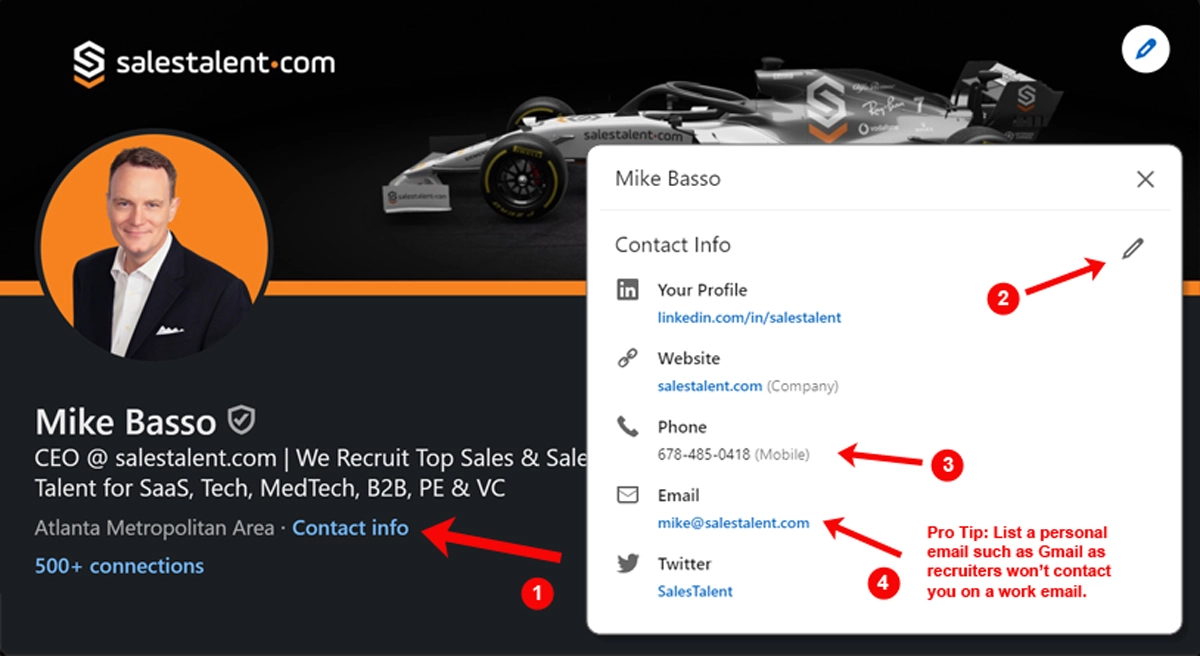
Make it Clear, Don’t Make Them Guess
When sourcing candidates, my team and I often see LinkedIn profiles that give little clue as to how they fit with the Ideal Candidate Profile we seek.
For example, Director of Business Development is a title we often see for both salespeople and sales leaders. Many LinkedIn profiles offer no insight into whether the person is a salesperson or a sales leader. This also happens with the VP of Sales role since title inflation leads companies to give VP of Sales titles to Enterprise Account Executives.
To avoid being overlooked, be sure to optimize your LinkedIn headlines, titles, about sections, and work experience to provide a clear understanding of your role, responsibilities, and accomplishments.
Open Profile
The Open Profile Premium feature allows anyone on LinkedIn to contact a Premium member for free, even without a LinkedIn 1st connection. Open Profile members must have a Premium subscription such as LinkedIn Premium Career, LinkedIn Sales Navigator, or LinkedIn Premium Business.
By turning on the Open Profile option, recruiters won’t need to be connected to you or spend an InMail credit to reach you through LinkedIn. You may get occasional spam, but giving recruiters another easy way to contact you is worth it.
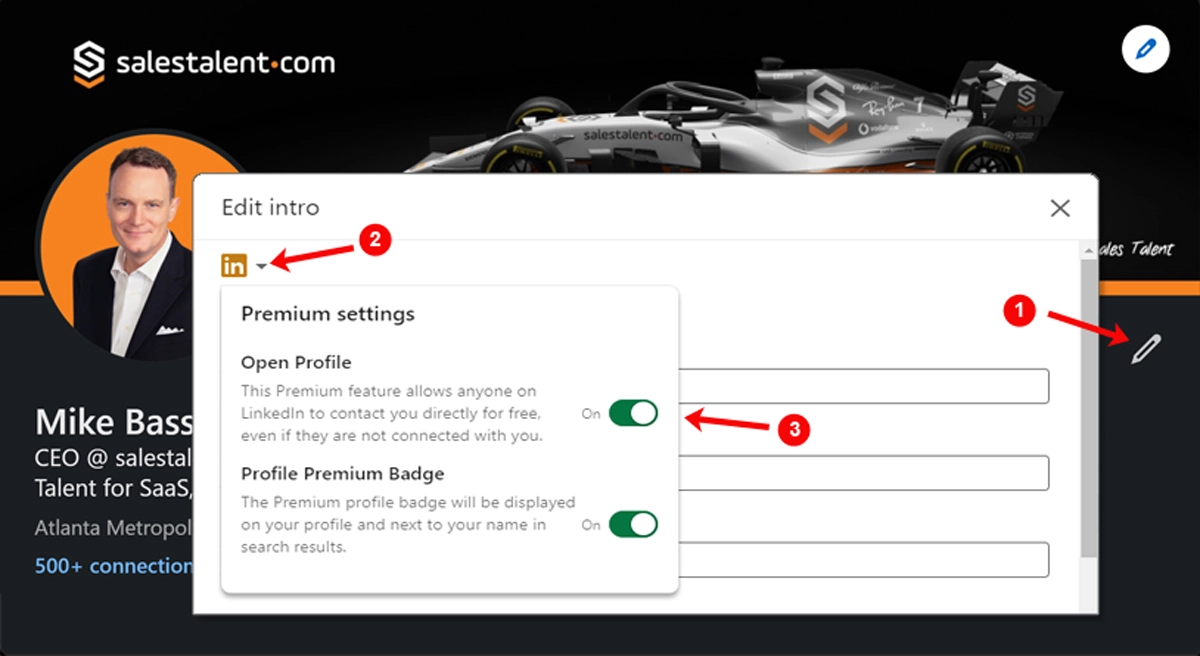
LinkedIn Groups
The advantage of joining LinkedIn groups is giving recruiters another way to contact you through LinkedIn if they are not a 1st connection.
LinkedIn Groups are online communities within LinkedIn where professionals can share content and discuss topics of common interest. Among the key things to know about LinkedIn Groups:
-
- Groups are organized around industries, professions, interests, affiliations, and more. There are groups for everything from marketing to HR to engineering.
- You don’t need a premium LinkedIn subscription to join groups, but having a premium subscription allows you to join more groups than free members.
- Once in a group, members can post discussions, share articles, ask questions, and message other group members.
- Groups have moderators who manage discussions and membership.
- Groups can be open to all LinkedIn members or closed and require approval to join.
- Participating in relevant groups allows you to establish yourself as an expert, get advice from other members, find and share information, and make connections.
- Groups can help boost your visibility and expand your network on LinkedIn.
Here are some of the sixty groups I belong to:
When selecting LinkedIn groups, you should consider relevancy and reach. Reach is the number of members in each group. Joining larger and more relevant groups increases the number of recruiters who can message you without being connected.
By following the recommendations in this chapter—adding contact details, optimizing your profile for clarity, enabling Open Profile, and joining relevant groups—you make yourself more visible and contactable to recruiters. Implement these simple yet impactful steps and watch your LinkedIn inbox fill up with exciting opportunities as recruiters easily find and reach out to you.
Chapter 5:
Passive vs. Applicant
Sought after vs. desperately seeking
This chapter will help you understand how recruiters view passive candidates versus applicants. Hopefully, you will be convinced that being a sought-after passive candidate is better than being a commoditized applicant lost in the shuffle. Quality passive candidates who are easy to spot with well-defined LinkedIn profiles are in short supply and, thus, in demand.
Some may disagree and shout of unfairness when I champion the idea that being a passive candidate is vastly superior to being an applicant.
Here is why you don’t want to be an applicant:
➤ Many companies, especially large ones, have numerous positions in their (ATS) Applicant Tracking System that automatically feed their website, LinkedIn, and job boards whether a position is open or not.
➤ Job postings also happen when an internal candidate is considered for an open role. In this scenario, an external job post can go live automatically or as a formality. The job is often posted externally, so they can say external sources were considered before the internal candidate is given the position.
➤ The most significant reason not to be an applicant is that you will likely get lost in the shuffle. Job postings today get hundreds, if not thousands, of applicants. LinkedIn Easy Apply and resume parsers that automatically fill application fields make it easy to mass apply to many jobs. Because it is easy to apply to most jobs, applicants give less consideration to the jobs they apply for. These pray-and-spray applicants make it harder for the few suitable applicants to cut through the noise. Clients often hire our firm because they do not have time to find the gem among hundreds or thousands of resumes.
➤ Many well-known and respected career coaches, such as Austin Belcak, Patricia Romboletti, and Will Rippetoe, echo the message that applying to jobs online has very low odds of success and is generally a waste of time.
People can apply to hundreds or thousands of jobs and hear nothing but crickets. Becoming a recruiter magnet is about separating yourself from the masses.
Don’t follow the herd. Break away! Take the time to optimize your LinkedIn profile, connect with relevant recruiters, and define yourself for a handful of specific roles.
If I have convinced you that being an applicant is not a wise career strategy, read on, and let’s dive deep into how being a passive candidate can change your career trajectory as it did for me.
Why passive candidates are sought after
🟢 Perceived Quality: Passive candidates are commonly perceived to be satisfied with their current roles because they are successful. They are not seeking employment due to discontentment or failure in their current role, indicating they will likely be successful in their next role.
🟢 Less Competition: Passive candidates do not actively apply to multiple positions, so there’s less competition when recruiting them. Active job seekers may have several offers or interviews simultaneously, and attracting them might require a more competitive offer or a quicker decision-making process.
🟢 Cultural Fit: If a recruiter approaches a passive candidate from a similar industry or competitor, there may be a higher chance of a cultural fit. They are already accustomed to the industry culture, standards, and technologies or methodologies.
🟢 Strategic Hiring: Recruiting passive candidates allows employers to target specific skills, experiences, or talents that align perfectly with their needs. Instead of sorting through numerous applications, recruiters can identify and approach individuals with the qualifications they seek, leading to more successful hires.
🟢 Better Integration: Since passive candidates are not desperate to leave their current positions, they often evaluate new opportunities thoroughly, ensuring a better fit and smoother integration into a new role or company culture.
As I briefly mentioned in the introduction to this guide, my decision to stop applying to job posts and become a recruiter magnet and well-defined passive candidate had the greatest impact on my career trajectory and income. The transition to an irresistible passive candidate did not happen overnight. It took time and hard work. I focused on completing the steps and tasks I detailed in this guide.
Successful people do what the unsuccessful are unwilling to do. Anybody can be a mass applicant. Few will do what it takes to be a recruiter magnet.
The benefits of being a passive candidate
🟢 Negotiation Leverage: Passive candidates are not actively seeking a new job and can negotiate more effectively. You can insist on better compensation, benefits, or other conditions because you don’t “need” the new job.
🟢 Reduced Pressure: Actively looking for a job can be stressful and time-consuming. Being a passive candidate allows you to continue focusing on your current position without the pressure to find something new.
🟢 Quality Opportunities: Often, recruiters or companies approach passive candidates because of their specific skills, experience, or fit for a particular role. This leads to opportunities more aligned with the candidate’s career goals or interests.
🟢 Professional Perception: Being approached by recruiters or potential employers can boost a person’s professional self-image. It’s a sign that your skills and experience are in demand and can affirm your value in the job market.
🟢 Less Competition: Typically, positions offered to passive candidates are part of a targeted search rather than a general job posting. This often means less competition for the role, as it may not be widely advertised.
🟢 Personalized Attention: When a recruiter or company reaches out to a passive candidate, they provide more personalized attention and assistance throughout the hiring process, recognizing the unique situation and value the candidate offers.
🟢 Alignment with Long-term Goals: Passive candidates often have the luxury of being selective, only entertaining opportunities that align with their long-term career goals and personal values.
RED ALERT #5: It is critical to understand that transitioning from applicant to sought-after passive candidate requires planning. Being unemployed makes it more challenging to benefit from being a passive candidate. Those who are unemployed should follow the steps in this guide, but no one should wait until they are unemployed to start this process.
Open to Work
CAUTION: If you want to avoid being passed over by anyone seeking passive candidates, don’t use the LinkedIn Open to Work picture frame option.
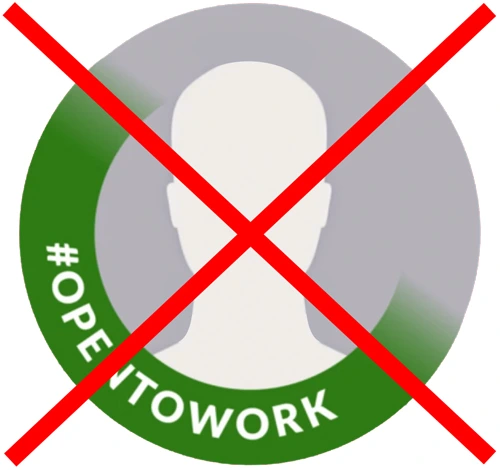
Whether you should or should not use the Open to Work photo frame is somewhat controversial. The results of a LinkedIn poll I ran in early 2023 showed people are evenly split on whether the Open to Work helps or hinders.
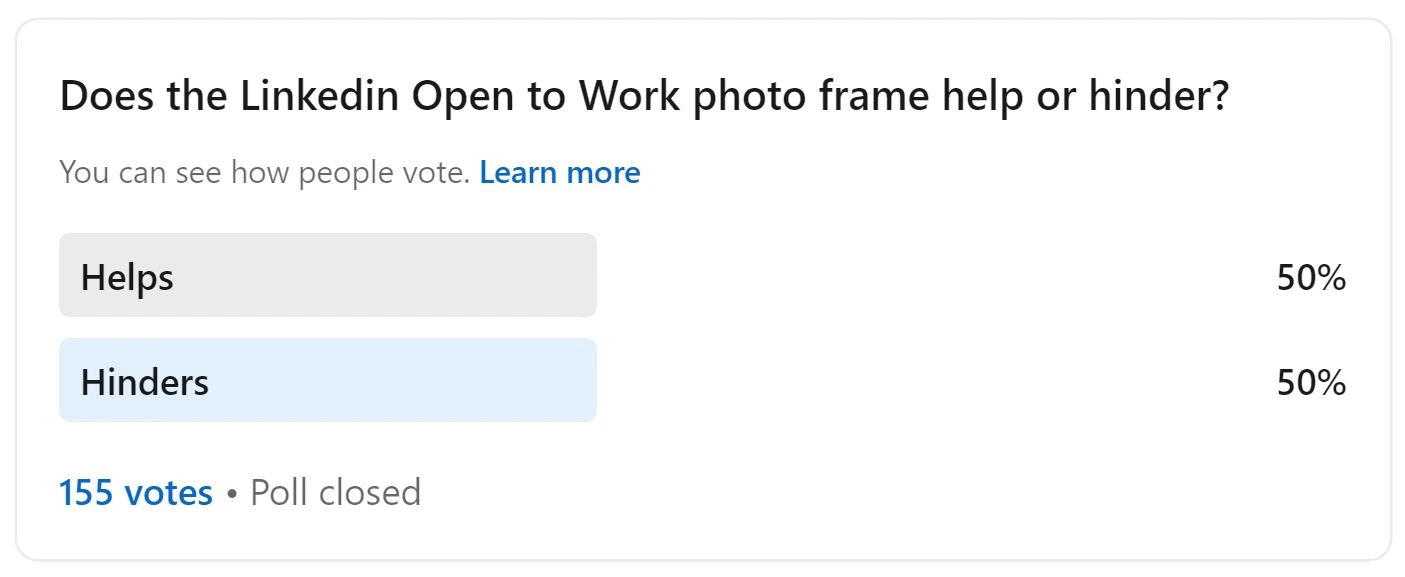
I believe the Open to Work frame hinders more than it helps, and most recruiters agree with me on the subject. While people believe the Open to Work frame brings more opportunities to come their way, my experience is that it has the opposite effect.
Hurts more than helps
Bias: Potential bias exists against those who declare they’re looking for work. The Open to Work status creates uncertainty about why the person is out of work or if they have an underlying issue.
Perception: Some recruiters or employers interpret the “Open to Work” feature as a sign of desperation or that the candidate is interested in any job, not their specific job.
This chapter explored the advantages of being a passive candidate versus an active applicant. To harness these benefits, it’s essential to be proactive, optimizing your LinkedIn presence and making recruiter connections before reaching the point of urgency. Being a recruiter magnet isn’t about mere chance; it’s about strategy, distinction, and foresight.
Chapter 6:
Making Connections
Maximizing your visibility
One of the most impactful actions I took to become a recruiter magnet was proactively connecting with recruiters, which brought two significant benefits.
➤ Connecting with relevant sales recruiters put me on their radar for current or future opportunities.
➤ By becoming a connection, recruiters could easily message me when they had opportunities that matched my well-defined LinkedIn profile.
RED ALERT #4: Your goal and approach should be to get on relevant recruiters’ radar for current and future opportunities, not obtain a call with them.
Many recruiters are busy seeking ideal candidates for their current roles. They don’t have time to meet with everyone who messages them if there isn’t a match with their current positions. However, many will add you to their database and mark you as active.
Let them reach back out to you. Most will review your profile when you connect, and if your optimized LinkedIn clearly spells out the roles you might fit, the recruiter will reach out when they have relevant roles. By asking for a call, you risk moving from a sought-after passive candidate to a desperately seeking applicant. Play it cool and slow, and let your magnetic profile draw them to you.
I had many opportunities come my way by connecting with recruiters. After reviewing my well-defined and optimized LinkedIn profile, those working on relevant opportunities contacted me.
The who, when, what, and how of connecting with recruiters.
Who?
Only connect with recruiters who specialize in your type of position. Don’t connect with an Executive Recruiter who only places C-level executives if you are a recent college grad. For me, relevant recruiters were those focused on sales talent.
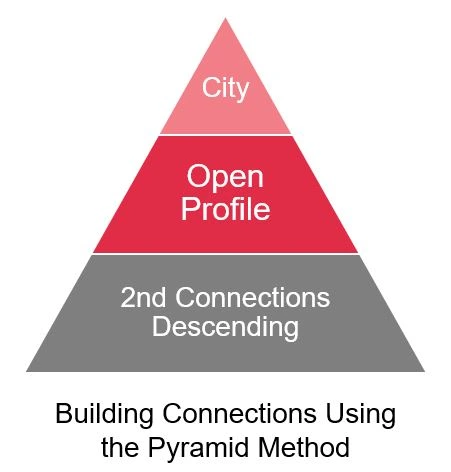
I recommend using the Pyramid Method to identify likely recruiters to connect with you.
The first filter is your metro area or a nearby metro area. Connect with relevant recruiters with a LinkedIn Open Profile badge within that marker and share connections with you. Expand beyond your initial sphere of influence after you connect with the most likely set of recruiters.
When
Invest in your future and connect with recruiters before you need a new job. Connecting with recruiters should be a long-term process that builds your network over time. Be proactive while you are happily employed. The old saying “The best time to look for a job is when you already have one” is excellent advice to follow. This strategy allowed me to look at many opportunities and only accept the right ones.
How
LinkedIn limits the number of connection requests you can send weekly (100 to 200 per week). The percentage of those who connect with you will be determined mainly by your LinkedIn profile, who you try to connect with, and your connection message.
What
What is the best connection message? The message should be short, relevant, and straightforward. Be sure to address them by first name, but further personalization is unnecessary.
Here is the message I used for years that received a 60% acceptance rate:
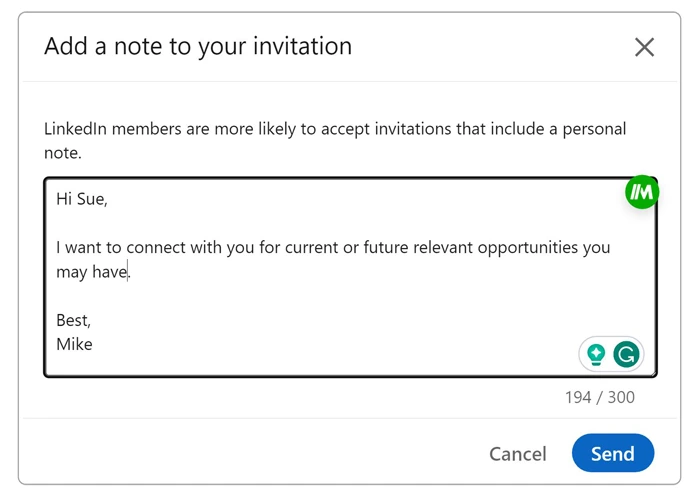
The messaging is nothing special, but it was very effective for me.
Note: I use Magical Text Expander to simplify LinkedIn messaging. It allows you to type three characters you choose, such as (rcm), to grab their first name from LinkedIn and autofill your message.
A proactive connection is critical for maximizing visibility with recruiters. Choosing relevant recruiters and engaging with them strategically ensures you remain on their radar for suitable opportunities. A well-optimized LinkedIn profile and a cool and calculated approach help you transition from an applicant to a sought-after candidate. Play it cool, and let your profile magnetically draw recruiters to you.
Conclusion
Your LinkedIn profile is a personal advertisement that tells a compelling story of your accomplishments, and recruiters review profiles like yours, seeking candidates that match open positions.
This guide outlines a step-by-step process to create an up-to-date and optimized profile that helps recruiters match relevant opportunities with your skills and experiences. Following these steps is the ultimate investment in your career and ensures your consideration for many future roles.
I encourage you to use this guide to begin your recruiter magnet journey today!
By: Mike Basso, CEO of salestalent.com
Share on Social Media
Recruiter Magnet Frequently Asked Questions
FAQs provided by claude.ai
Q: Why is it important to become a recruiter magnet?
A: Becoming a recruiter magnet is important because it gives you access to the hidden job market (60-80% of job opportunities), reduces competition, increases your perceived value, and can lead to better career opportunities and higher income.
Q: What are the two most critical elements of your LinkedIn profile for attracting recruiters?
A: The two most critical elements are your profile photo and headline. These are the first things recruiters see and use to make split-second decisions about whether to view your full profile.
Q: How much time should you spend optimizing your LinkedIn profile?
A: The guide recommends spending at least six hours optimizing your profile, with specific time allocations for different sections such as 2 hours for the About section and 3 hours for the Experience section.
Q: What is the “Magnetic Formula” for creating an attractive LinkedIn profile?
A: The Magnetic Formula consists of five components: Clarity of Ideal Candidate Profile, Completeness and quality, Differentiating, Content, format, and aesthetics, and Regular updates and optimization.
Q: Why is it better to be a passive candidate rather than an active applicant?
A: Passive candidates are often perceived as higher quality, face less competition, may be a better cultural fit, and have more negotiation leverage. They also benefit from reduced pressure and more personalized attention from recruiters.
Q: Should you use the LinkedIn “Open to Work” photo frame?
A: The guide advises against using the “Open to Work” photo frame, as it can create bias and may be perceived negatively by some recruiters and employers.
Q: How can you make it easier for recruiters to contact you?
A: You can make it easier by adding your personal email and mobile number to your LinkedIn profile, enabling the Open Profile feature (if you have a Premium account), and joining relevant LinkedIn groups.
Q: What is the recommended approach for connecting with recruiters on LinkedIn?
A: The guide suggests using the “Pyramid Method” to identify relevant recruiters, connecting before you need a job, and using a short, straightforward connection message. It’s also advised to let recruiters reach out to you rather than asking for immediate calls.
Q: How often should you update your LinkedIn profile?
A: The guide emphasizes the importance of regular updates and optimization. It’s recommended to keep a journal of your accomplishments and update your profile accordingly.
Q: What’s the significance of having a professional photo on your LinkedIn profile?
A: A professional photo is crucial as most recruiters won’t click on profiles without photos. The guide states that a professional photo is the best investment you can make, with the author’s $299 studio photo having returned hundreds of thousands of dollars in career opportunities.
A NATIONAL SALES RECRUITMENT AGENCY
If you seek top sales recruiters to hire high-performing sales talent, our sales recruiting agency has experienced sales headhunters to get the specific sales professionals you seek.
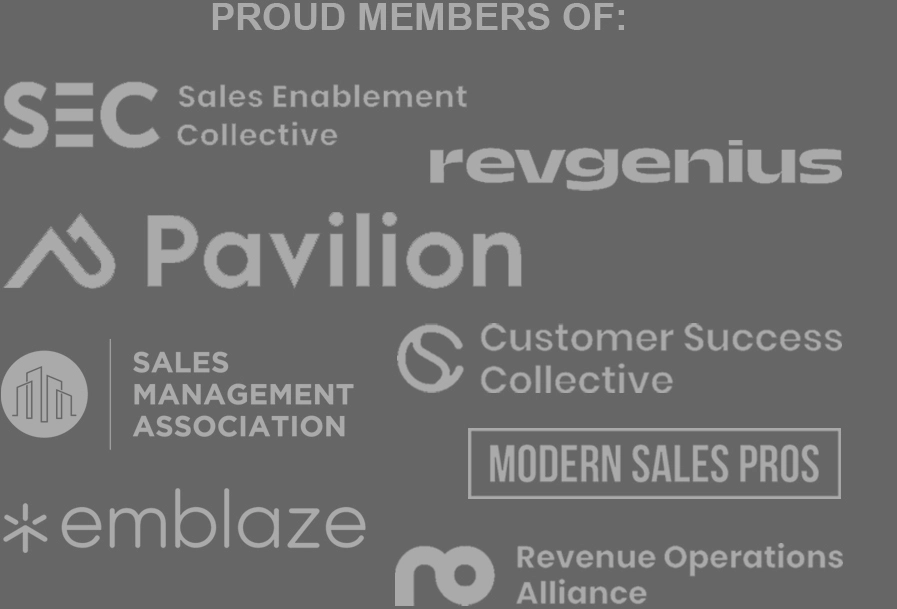
AREAS WE SERVE
Atlanta | Austin | Baltimore | Boston | Charlotte | Chicago | Cincinnati | Dallas | Detroit | Denver | Houston | Indianapolis | Jacksonville | Kansas City | Los Angeles | Miami | Minneapolis | Nashville | New York | Philadelphia | Phoenix | Pittsburgh | Portland | Raleigh | Salt Lake City | San Diego | San Francisco | Seattle | Tampa | San Jose | St. Louis | Washington DC | USA
SECTORS WE SERVE


